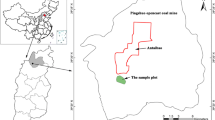Abstract
The expansion of poisonous plants can change vegetation community structures and affect grassland ecosystem service values. Stellera chamaejasme is one of the most important poisonous plants and has rapidly expanded in the arid areas of Northwest China in recent decades. The objective of this study was to elucidate the expansion process and model of an S. chamaejasme population. Therefore, we classified the S. chamaejasme population into five classes based on coverage: 31–40%, 41–50%, 51–60%, 61–70% and 71–80%. We investigated the spatial distribution patterns and the size compositions of S. chamaejasme under different coverages. The results show that the spatial distribution pattern of S. chamaejasme under low coverage (31–40%) at all study scales (0–100 cm) was random; the spatial distribution pattern translated to a clumped distribution from a random distribution at some scales, and the clumped distributions gradually became obvious, with coverage increasing from 41–50% to 61–70%; the spatial distribution tended to be random at all study scales when coverage was increased further (71–80%). However, the spatial distribution patterns were closely related to the size composition of the S. chamaejasme population. In particular, the quantity of older individuals had a significant impact on the variation of the spatial distribution patterns of S. chamaejasme. The spatial distribution pattern varied from a random distribution to a clumped distribution and then returned to a random distribution with increasing coverage (from 31–40% to 71–80%), and this may indicate that the S. chamaejasme patches experienced patch formation and extension and merged with each other.




Similar content being viewed by others
References
Callaway RM, Kikodze D, Chiboshvili M, Khetsuriani L (2005) Unpalatable plants protect neighbors from grazing and increase plant community diversity. Ecology 86:1856–1862
Cheng W, Sun G, Du LF, Wu Y, Zheng QY, Zhang HX, Liu L, Wu N (2014) Unpalatable weed Stellera chamaejasme L. provides biotic refuge for neighboring species and conserves plant diversity in overgrazing alpine meadows on the Tibetan Plateau in China. J Mt Sci 11:746–754
Evans RD, Rimer R, Sperry L, Belnap J (2001) Exotic plant invasion alters nitrogen dynamics in an arid grassland. Ecol Appl 11:1301–1310
Gao FY, Shi FX, Chen HM, Zhang XH, Yu XY, Cui Q, Zhao CZ (2018) Rapid expansion of Melica przewalskyi causes soil moisture deficit and vegetation degradation in subalpine meadows. Clean Soil Air Water 46
Grey-Wilson C (1995) Stellera chamaejasme: an overview. New Plantsman 2:43–49
Huang ZJ, Zhou SQ (1993) The important toxic plant on grassland-Stellera chamaejasme L. Pratacul Anim Husb 4:22–27 (In Chinese)
Illian J, Penttinen A, Stoyan H, Stoyan D (2008) Statistical analysis and modelling of spatial point patterns. Wiley, New York
Milchunas DG, Noy-Meir I (2002) Grazing refuges, external avoidance of herbivory and plant diversity. Oikos 99:113–130
Ren GH, Deng B, Shang Z, Hou Y, Long RJ (2013) Plant communities and soil variations along a successional gradient in an alpine wetland on the Qinghai-Tibetan Plateau. Ecol Eng 61:110–116
Ripley BD (1988) Statistical inference for spatial processes. Biometrics:46
Sun G, Luo P, Wu N, Qiu PF, Gao YH, Chen H, Shi FS (2009) Stellera chamaejasme L. increases soil N availability, turnover rates and microbial biomass in an alpine meadow ecosystem on the eastern Tibetan Plateau of China. Soil Biol Biochem 41:86–91
Wang Y, Gilbert MG (2007) Stellera Linnaeus. In: Wu Z-Y, Raven PH (eds) Flora of China. Science Press, Beijing
Wang FS, He YT, Pl S, Niu B, Zhang XZ, Xu XL (2016) Stellera chamaejasme as an indicator for alpine meadow degradation on the Tibetan Plateau. Chin J Appl Environ Biol 22:0567–0572 (in Chinese with English abstract)
Wiegand T, Moloney KA (2010) Rings, circles, and null-models for point pattern analysis in ecology. Oikos 104:209–229
Xing F, Song R (2002) Population distribution pattern and dynamics of poisonous Stellera chamaejasme on grassland. Pratacul Sin 19:16–19 (in Chinese with English abstract)
Xing F, Wang YH, Guo JX (2004) Spatial distribution patterns and dispersal mechanisms of the seed population of Stellera chamaejasme on degraded grasslands in Inner Mongolia, China. Acta Ecol Sin 24:143–148
Zhang ZQ, Zhang YH, Sun H (2011) The reproductive biology of Stellera chamaejasme (Thymelaeaceae): a self-incompatible weed with specialized flowers. Flora 206:567–574
Zhao CZ, Fan SY, Yin CQ, He XB (2004) Study on vegetation community’s structure of degraded grassland of noxious and miscellaneous grass type. J Desert Res 24:507–512 (in Chinese with English abstract)
Zhao CZ, Gao FY, Wang XP, Sheng YP, Shi FX (2010) Fine-scale spatial patterns of Stellera chamaejasme population in degraded alpine grassland in upper reaches of Heihe, China. Chin J Plant Ecol 34:1319–1326 (in Chinese with English abstract)
Funding
This work was supported by the National Natural Science Foundation of China (No. 41661014), the Natural Science Foundation of Gansu province (No. 18JR3RA221) and Opening Fund of Key Laboratory of Land Surface Process and Climate Change in Cold and Arid Regions, CAS (LPCC2018006).
Author information
Authors and Affiliations
Corresponding author
Additional information
Responsible editor: Philippe Garrigues
Publisher’s note
Springer Nature remains neutral with regard to jurisdictional claims in published maps and institutional affiliations.
Rights and permissions
About this article
Cite this article
Gao, F., Li, K., Zhao, C. et al. The expansion process of a Stellera chamaejasme population in a degraded alpine meadow of Northwest China. Environ Sci Pollut Res 26, 20469–20474 (2019). https://doi.org/10.1007/s11356-019-05421-6
Received:
Accepted:
Published:
Issue Date:
DOI: https://doi.org/10.1007/s11356-019-05421-6




